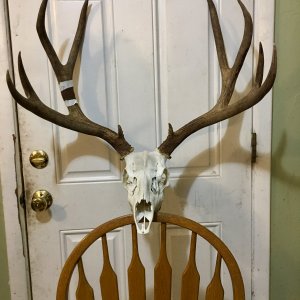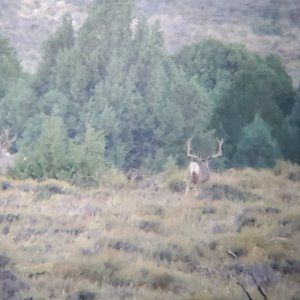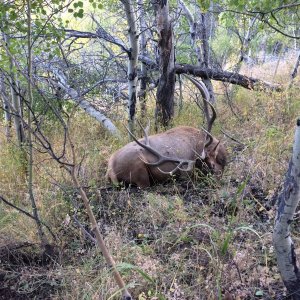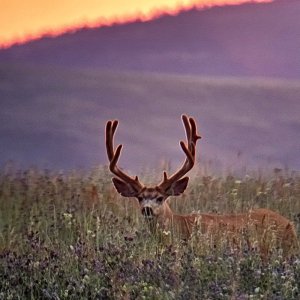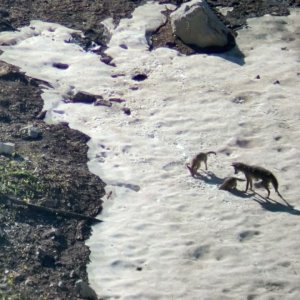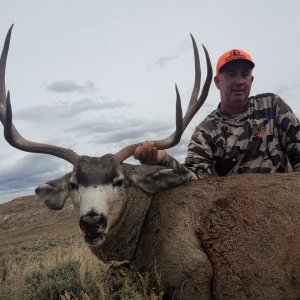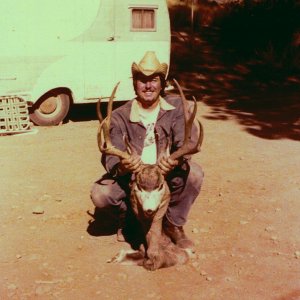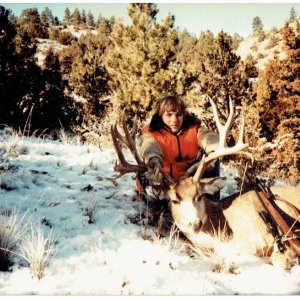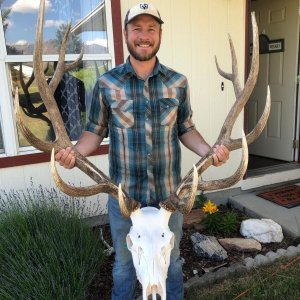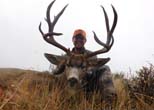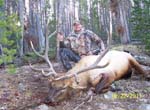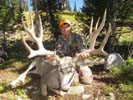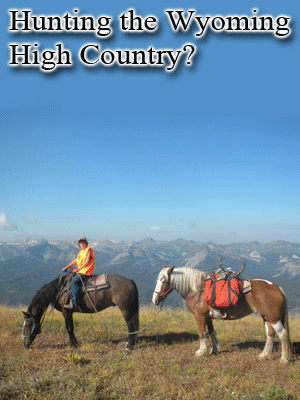T
TFinalshot
Guest
Is this fact or another one of those left-wing ploys to alter the truth for political purposes? Is this just like the global warming debate, split down political lines, or are people actually going the listen to the issues? To me, it's like the guy who drives his pickup for 5 years and suddenly the temp gage shows hot. The guy driving it thinks that his truck never has let him down and that there must be something wrong with the gauge, so he keeps driving it and soon the pick up over heats and the engine blows. . . I'd say lets pay more attention to the gauges. . .
>BY ROLLIN D. SPARROWE
>
>The recent release of research findings from the fifth year of vital studies
>of mule deer use of the Mesa on the Pinedale Anticline has again produced a
>customary "spin-doctoring" that has characterized the debate over Wyoming's
>wildlife affected by energy development.
>
>Headlines like "Mesa Herd Stabilizes" published in local newspapers do a disservice to both deer and the interests of Wyoming deer hunters.
>
>The facts, however, are that: 1. There are fewer than half the deer using the Mesa in winter than there were five years ago; 2. There is no evidence
>that any meaningful numbers of those deer have "just gone elsewhere" (as >was
>suggested in 2005 by the federal Bureau of Land Management which is >supposed
>to have oversight that protects the herd); and 3. New data show that only
>two percent may have emigrated from the Mesa, but that 27 percent of the
>total reduction in use can be attributed to energy development activities.
>
>These findings confirm that while many other factors affect deer, energy
>development activity is an important contributor to the reduction in use of
>the Mesa by deer.
>
>But let's get even more to the point.
>
>We just experienced a tough deer season in Western Wyoming. Northern >Wyoming
>Range and Hoback Basin deer hunters had trouble finding any deer, let alone
>good bucks. The common question at check stations and in the mountains was:
>"Where are the deer?"
>
>Movement data on deer that winter on the Mesa show that many of them moved
>into the Northern Wyoming Range and Hoback Basin. Sincere there were much
>fewer deer in that segment of the Sublette Deer Herd on the Mesa in winter,
>should it surprise us us that the quality of deer hunting in those >connected
>areas has declined sharply?
>
>The "stabilization" claim is based on the fact that deer on the mesa have
>numbered about 2,800 for two years, and didn't decline further-yet. But
>remember, five years ago there were almost 6,000-should we therefore be
>happy with half a herd?
>
>Of greater significance is that new data show reduced reproductive success
>in the Mesa herd versus neighboring herds. This adds up to bad news for the
>future of this deer herd, those who love to hunt deer in the Wyoming Range
>and Hoback Basin, and those communities that rely on the economic benefits
>from hunting.
>
>A MATTER OF HARSH SURVIVAL
>
>As a wildlife biologist with the federal Bureau of Land Management assigned
>to the agency's Pinedale office, Steve Belinda tried continuously to call
>his superiors' attention to impacts on mule deer, ponghorn, sage grouse and
>other species caused by an expanding footprint of gas drilling. But he says
>his concerns were constantly ignored and he was marginalized. Finally, he
>resigned in disgust and went to work as a staff expert with the Theodore
>Roosevelt Conservation Partnership. Belinda is also a committed sportsman.
>This photo was taken in spring 2005 on the Pinedale Anticline while Mr.
>Belinda was still employed by BLM. Today, thousands of new gas wells are
>proposed for the Mesa area of the Anticline mentioned in Sparrowe's essay.
>The Wind River Mountains loom in the distance. Photo by Todd Wilkinson.
>
>Drought, predators, houses, roads, and other factors that influence these
>deer have been a part of the mule deer world for a long time, but during
>previous drought and periodic severe winters, Mesa deer have been able to
>use the Mesa and adjacent habitat to cope with winter snows, wind and
>extreme cold. Now they cannot do that.
>
>What is new and NOT natural is the high level of human disturbance and
>change int he landscape brought on by energy development.
>
>The real issue is not arguing over which influence is worse than the other,
>but given the likelihood of periodic harsh Wyoming winters, can these deer
>still survive and recover?
>
>We may well get an answer soon. The Wyoming Game and Fish Department warned
>us this year that even with moderate winter, current poor forage conditions
>make a die-off likely, so protections from winter disturbance are extremely
>important. Mule deer are now at a crossroads where they are clearly in
>trouble under heavy development pressure.
>
>It seems clear that some part of energy development has to be scale back or
>deer and deer hunters will lose even more than they already have. And yet,
>the signs are not good-leasing to drill on migration and summer ranges
>threats the REST of the annual deer habitat.
>
>Recently, the BLM had to withdraw proposals for leases near Merna because
>they had NOT evaluated their importance to Mesa deer. There has been an
>uprising of hunters and outfitters opposing further development in the
>Wyoming Range.
>
>When petititioned last spring by the citizen-based Pinedale Anticline
>Working Group (whose formation was promoted by the BLM as a form of >outreach
>to citizens and user groups) to adopt goals of no further reduction in this
>herd, BLM REFUSED.
>
>All that was proposed by BLM was to get the BLM, Wyoming Game and Fish
>Department, industry and other interested publics together to consider what
>might be done differently to ease the pressure on this herd.
>
>BLM promised to "work with the Game and Fish Department to find ways to
>assist the herd." This winter, the BLM released a draft Supplemental
>Environmental Impact Statement for the Pinedale Anticline based on a
>proposal from industry that will include a major increase in activity on
>parts of the Mesa in winter.
>
>This is apparently in trade for less activity elsewhere. Hunters and others
>must examine this proposal carefully. Is more winter drilling the best we
>can expect from the key federal management agency?
>
>NOT AN ISOLATED INCIDENT
>
>This bad scenario for mule deer is being re-enacted elsewhere, such as the
>Atlantic Rim in southcentral Wyoming, Piceance Basin and Roan Plateau in
>Colorado, and Book Cliffs in Utah and Colorado.
>
>No one has the ability to evalucate the effects on mule deer of tens of
>thousands of well sites in the Powder River Basin of Montana and Wyoming.
>This fast pace of development is cutting at the very heart of some of the
>most valued mule deer locations in the Northern Rockies and none of our
>agencies are fully taking care of our interests.
>
>Residents and nonresident hunter dollars are the biggest support base for
>Wyoming wildlife programs.
>
>It is time to quit being satisfied with "half a deer herd."
>
>Hunters should demand nothing less than action from government and industry
>to arrest the decline of the "stabilized" Mesa Herd and assure that the >same
>decline does not happen in other key mule deer herds.
>
>Partners in the Theodore Roosevelt Conservation Partnership have devleoped >a
>set of principles to assist wildlife through the onslaught of energy
>development. They may be viewed at
><http://www.newwest.net/index.php?URL=http://www.trcp.org>
>http://www.trcp.org
>
>We welcome partnership with hunters, anglers, organizations, busiensses and
>everyone else who cares about the future of mule deer and other wildlife
>affected by energy development. We say it is not being "done right"-mule
>deer are a prime example and half a mule deer herd is not acceptable.
>BY ROLLIN D. SPARROWE
>
>The recent release of research findings from the fifth year of vital studies
>of mule deer use of the Mesa on the Pinedale Anticline has again produced a
>customary "spin-doctoring" that has characterized the debate over Wyoming's
>wildlife affected by energy development.
>
>Headlines like "Mesa Herd Stabilizes" published in local newspapers do a disservice to both deer and the interests of Wyoming deer hunters.
>
>The facts, however, are that: 1. There are fewer than half the deer using the Mesa in winter than there were five years ago; 2. There is no evidence
>that any meaningful numbers of those deer have "just gone elsewhere" (as >was
>suggested in 2005 by the federal Bureau of Land Management which is >supposed
>to have oversight that protects the herd); and 3. New data show that only
>two percent may have emigrated from the Mesa, but that 27 percent of the
>total reduction in use can be attributed to energy development activities.
>
>These findings confirm that while many other factors affect deer, energy
>development activity is an important contributor to the reduction in use of
>the Mesa by deer.
>
>But let's get even more to the point.
>
>We just experienced a tough deer season in Western Wyoming. Northern >Wyoming
>Range and Hoback Basin deer hunters had trouble finding any deer, let alone
>good bucks. The common question at check stations and in the mountains was:
>"Where are the deer?"
>
>Movement data on deer that winter on the Mesa show that many of them moved
>into the Northern Wyoming Range and Hoback Basin. Sincere there were much
>fewer deer in that segment of the Sublette Deer Herd on the Mesa in winter,
>should it surprise us us that the quality of deer hunting in those >connected
>areas has declined sharply?
>
>The "stabilization" claim is based on the fact that deer on the mesa have
>numbered about 2,800 for two years, and didn't decline further-yet. But
>remember, five years ago there were almost 6,000-should we therefore be
>happy with half a herd?
>
>Of greater significance is that new data show reduced reproductive success
>in the Mesa herd versus neighboring herds. This adds up to bad news for the
>future of this deer herd, those who love to hunt deer in the Wyoming Range
>and Hoback Basin, and those communities that rely on the economic benefits
>from hunting.
>
>A MATTER OF HARSH SURVIVAL
>
>As a wildlife biologist with the federal Bureau of Land Management assigned
>to the agency's Pinedale office, Steve Belinda tried continuously to call
>his superiors' attention to impacts on mule deer, ponghorn, sage grouse and
>other species caused by an expanding footprint of gas drilling. But he says
>his concerns were constantly ignored and he was marginalized. Finally, he
>resigned in disgust and went to work as a staff expert with the Theodore
>Roosevelt Conservation Partnership. Belinda is also a committed sportsman.
>This photo was taken in spring 2005 on the Pinedale Anticline while Mr.
>Belinda was still employed by BLM. Today, thousands of new gas wells are
>proposed for the Mesa area of the Anticline mentioned in Sparrowe's essay.
>The Wind River Mountains loom in the distance. Photo by Todd Wilkinson.
>
>Drought, predators, houses, roads, and other factors that influence these
>deer have been a part of the mule deer world for a long time, but during
>previous drought and periodic severe winters, Mesa deer have been able to
>use the Mesa and adjacent habitat to cope with winter snows, wind and
>extreme cold. Now they cannot do that.
>
>What is new and NOT natural is the high level of human disturbance and
>change int he landscape brought on by energy development.
>
>The real issue is not arguing over which influence is worse than the other,
>but given the likelihood of periodic harsh Wyoming winters, can these deer
>still survive and recover?
>
>We may well get an answer soon. The Wyoming Game and Fish Department warned
>us this year that even with moderate winter, current poor forage conditions
>make a die-off likely, so protections from winter disturbance are extremely
>important. Mule deer are now at a crossroads where they are clearly in
>trouble under heavy development pressure.
>
>It seems clear that some part of energy development has to be scale back or
>deer and deer hunters will lose even more than they already have. And yet,
>the signs are not good-leasing to drill on migration and summer ranges
>threats the REST of the annual deer habitat.
>
>Recently, the BLM had to withdraw proposals for leases near Merna because
>they had NOT evaluated their importance to Mesa deer. There has been an
>uprising of hunters and outfitters opposing further development in the
>Wyoming Range.
>
>When petititioned last spring by the citizen-based Pinedale Anticline
>Working Group (whose formation was promoted by the BLM as a form of >outreach
>to citizens and user groups) to adopt goals of no further reduction in this
>herd, BLM REFUSED.
>
>All that was proposed by BLM was to get the BLM, Wyoming Game and Fish
>Department, industry and other interested publics together to consider what
>might be done differently to ease the pressure on this herd.
>
>BLM promised to "work with the Game and Fish Department to find ways to
>assist the herd." This winter, the BLM released a draft Supplemental
>Environmental Impact Statement for the Pinedale Anticline based on a
>proposal from industry that will include a major increase in activity on
>parts of the Mesa in winter.
>
>This is apparently in trade for less activity elsewhere. Hunters and others
>must examine this proposal carefully. Is more winter drilling the best we
>can expect from the key federal management agency?
>
>NOT AN ISOLATED INCIDENT
>
>This bad scenario for mule deer is being re-enacted elsewhere, such as the
>Atlantic Rim in southcentral Wyoming, Piceance Basin and Roan Plateau in
>Colorado, and Book Cliffs in Utah and Colorado.
>
>No one has the ability to evalucate the effects on mule deer of tens of
>thousands of well sites in the Powder River Basin of Montana and Wyoming.
>This fast pace of development is cutting at the very heart of some of the
>most valued mule deer locations in the Northern Rockies and none of our
>agencies are fully taking care of our interests.
>
>Residents and nonresident hunter dollars are the biggest support base for
>Wyoming wildlife programs.
>
>It is time to quit being satisfied with "half a deer herd."
>
>Hunters should demand nothing less than action from government and industry
>to arrest the decline of the "stabilized" Mesa Herd and assure that the >same
>decline does not happen in other key mule deer herds.
>
>Partners in the Theodore Roosevelt Conservation Partnership have devleoped >a
>set of principles to assist wildlife through the onslaught of energy
>development. They may be viewed at
><http://www.newwest.net/index.php?URL=http://www.trcp.org>
>http://www.trcp.org
>
>We welcome partnership with hunters, anglers, organizations, busiensses and
>everyone else who cares about the future of mule deer and other wildlife
>affected by energy development. We say it is not being "done right"-mule
>deer are a prime example and half a mule deer herd is not acceptable.

